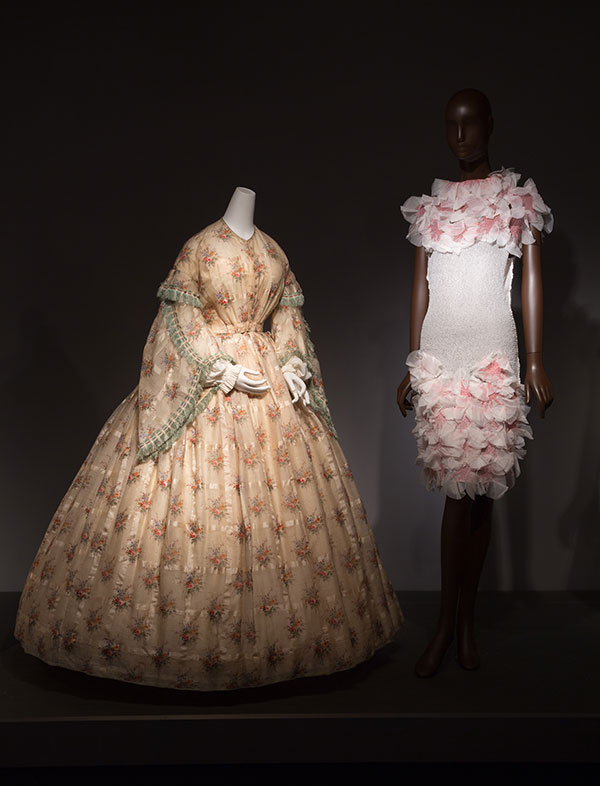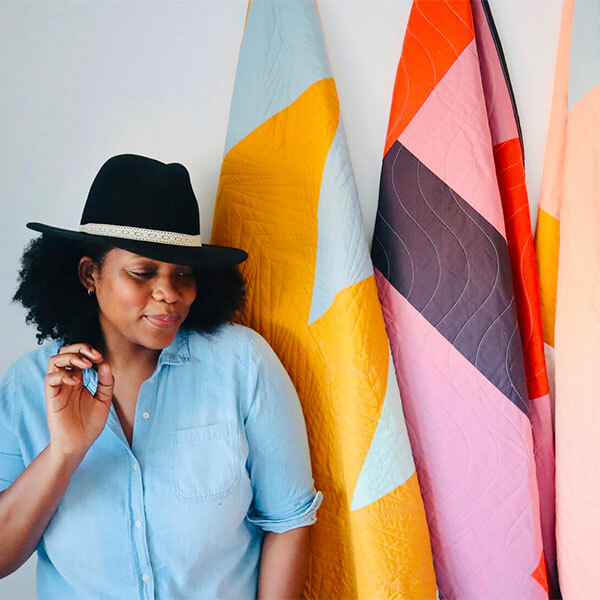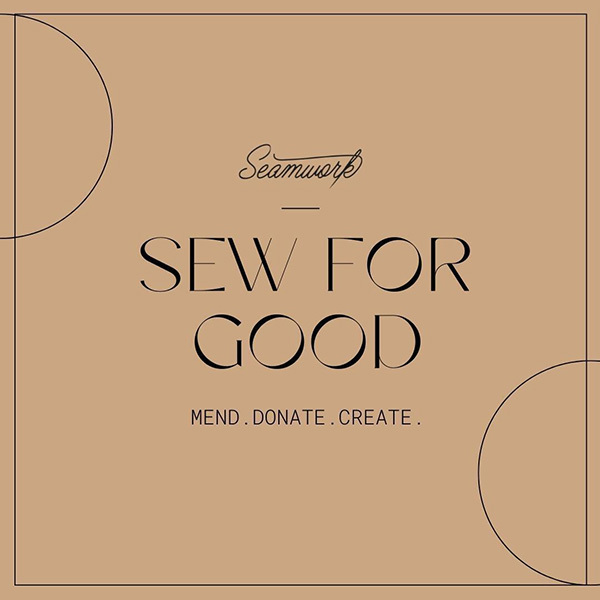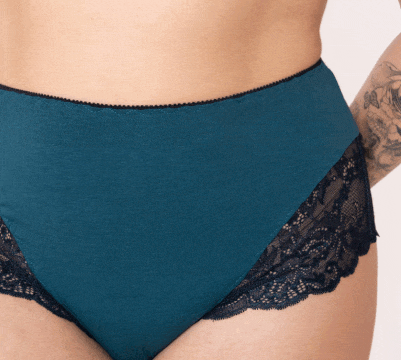Elizabeth Way has always loved fashion, but that doesn’t mean her life was a straight path towards becoming a costume historian, or the assistant curator of costume at the Museum at FIT, or the recipient of an Innovation in Collection award from the Museum Association of New York for the show Black Fashion Designers. Of course, as her friend, I always knew she could do it.
Liz and I met working in the undergraduate costume shop while pursuing masters in different programs at NYU, and we’ve been close friends ever since. Whether touring a block print factory in Rajasthan, eating our weight in duck in Singapore, or visiting exhibits in New York, Liz has infused my life with fashion history and knowledge—but it’s not just me. Her work as a curator has inspired many, and it all started with her love for fashion.
Liz's Journey Through Fashion, Sewing, and History
Liz grew up loving fashion, pouring over issues of Vogue as a teenager. While she originally planned to become a fashion designer, her industry experience after college was less engaging than she had hoped. She studied and worked her way through pattern cutting courses, advancing to an assistant costume designer at her alma matter—the University of Delaware. As Liz continued to look for the right career path, she turned to the master’s program at NYU in Costume Studies, which led her to costume history.

In addition to her degrees and work experience, Liz’s ability to sew is one of the many tools she uses as a historian. While Liz was taught to sew by her mother, it was a high school class on fashion technology that improved her skills, and then her time in college that gave her the skills she now has as a maker. Though Liz altered and restyled her clothing in high school, it’s only been in the last seven or eight years that she’s made more things for herself, partially inspired by the fabrics she and I have had access to in our travels in India—where I now live. All of this experience as a maker informs her work as an assistant curator of costume at MFIT.
Do you think that your knowledge of sewing and making informs your scholarship, and if so, how?
Liz: I do think it gives me a unique perspective. At the Museum at FIT, curators all have our own specialties and interests, and our own ways of approaching fashion.
For example, being a maker greatly influenced a show I curated, Fabric and Fashion. Part of that show was really examining the way fabric drapes and the way different patternmaking techniques affect different types of fabric.
This was a perspective that I took directly from my maker background. Another curator might have approached those same set of objects in a completely different way. I do think about fabrics and the way garments are made, and it does give me a little bit of knowledge to read a dress in a different way than maybe another curator might analyze it.
Curating the Museum at FIT
Regarding the museum’s collection, how far back do the objects date? How much is machine-made?
Liz: We have some shoes from the 17th century, but our oldest garments are from the 18th century.
The objects from the mid-1800s and earlier can be assumed to be handmade, though the fabric was probably machine woven. We can look at different markers in the clothes and make assessments. But the way people used to make clothes is very different from the way I would make them today, so sometimes my maker knowledge doesn’t give me as much information on historical garments as if I was looking at, say, a dress from the 1950s.
Our dependence on machines has changed the way we make clothing.
Our dependence on machines has changed the way we make clothing. Recently, I’ve done some research on dressmakers during the 19th century. Sewing machines became more commercially available around the 1840s, 1850s, but they weren’t that good—they weren’t as delicate as the machines we have now.

The professional seamstresses from this period, while they weren’t as skilled as dressmakers, still had a lot of knowledge. For example, when you were sewing a big skirt in this period, you need to use long, loose stitches in order for it to fall properly, but if you were sewing a bodice, you would need tight, overlapping stitches because the bodice is subject to so much strain.
A seamstress would really need to know the difference because the stitching affects how the dress hangs and the overall quality of the finished product. I was really interested to learn that because machine stitching has taken away some of that knowledge.

Tell me about your curation process. How have you chosen some of the shows you’ve worked on? How do you approach gathering information and presenting it?
Liz: Most of the shows I’ve worked on have been in support of other curators or co-curated with a colleague. So, I’ll contribute and blend in my ideas and perspectives.
Some exhibition ideas come up organically. For example, I’m curating an upcoming show with my colleague, Melissa Marra-Alvarez, on Food and Fashion. We were having a conversation about a show I wanted to do, something about taste and the senses, and it wasn’t coming together as a narrative I could bring to a set of objects. We talked about it over lunch, and the idea solidified into Food and Fashion.
Fabric and Fashion was a show I curated on my own, and I pitched the idea because I felt that the museum hadn’t touched on that subject in this specific way before.
As curators, we always want our shows to be fresh, and at MFIT, we want to present solid scholarship. When I pitch ideas to our director, Valerie Steele, she’s great about guiding me to develop shows that make sense for the general public, rather than just a fashion historian.
One of the pieces of advice she gave me was go look at the objects in our collection. Don’t start from a book or a theoretical idea—start from the object and see where it gets you. That’s really how Fabric In Fashion came into being.
Because FIT has such an extensive collection, I could find everything I needed there. For example, I used a dress from the 1850s made of extremely finely woven wool. I wanted to show garments whose fibers had the same visual aesthetics, so I chose four different fabrics that were translucent and off-white, and I found this wool dress that looked like cotton muslin. It had deteriorated over time, and one of our conservators, Marjorie Jonas—who has since retired—spent hours and hours conserving it. I was so lucky she did and that I could include it.
Clothes become fashion when people start thinking, talking, or writing about them—when they start dressing for a knowledgeable audience, even if that’s just themselves.


Just like we distinguish food and cuisine and create a hierarchy between what people cook and what a chef makes, we distinguish “what people wear” and fashion. How do you see that division? How has that worked historically? How does that work as a scholar, in what you study?
Liz: The old-school definition of fashion—which I think has changed a lot in the last decade—is that fashion started in Europe, during the medieval era. This is when we start to see people interested in changing styles—and fashion is defined as change. But for me, fashion is about discourse, and I think this is the distinction between cuisine and food, too.
Clothes become fashion when people start thinking, talking, or writing about them—when they start dressing for a knowledgeable audience, even if that’s just themselves.
More likely than not, all societies were and are thinking about clothing, perhaps competing in the way they dress. Historically and all over the world, people have always been interested in how they look and adorning themselves to be seen. I think that whenever and wherever people are having conversations about how they look and what they wear, then that’s fashion.
A material object becomes culture when people start thinking about it and talking about it.
Fashion is Inseperable from Culture, Race, and Change
Historically, a lot of fashion scholarship has marginalized non-Western clothing. Western fashion loves the material and resources from other cultural fashion spaces, but it ignores the clothing and the makers. Do you feel that there is a movement in fashion scholarship right now to decentralize, to move beyond the Western Fashion gaze?
Liz: Yes, I think there has been movement. Discussions about diversity have affected the fashion industry in a really big way, and I think fashion scholarship as well.
Fashion history has historically been very white, very upper class, but now, as diverse people are entering the field, new perspectives are introduced.
There are a lot of conversations to be had about “ethnic” dress. What is ethnic dress? Why does something get put into an anthropology museum or natural history museum versus a fashion or art museum?
These are all conversations that need to keep going, so we—as a field—can really figure out where our generation is going to stand. Our categorizations for ethnic dress tend to imply that these clothing cultures are static, unchanging, and that denies the evolution of these styles and fashions. And there are real consequences in thinking about people as historic institutions or as never changing.

For example—Native Indigenous people in the US. A generation ago (or even today), when we thought about Native peoples in the US, what was the image in our minds? Was it a historical image, or was it a living, breathing person who is existing in contemporary society just like we are? I think conversations on ethnic dress have an influence on what is happening—politically and culturally—right now.
There are a lot of conversations to be had about 'ethnic' dress. What is ethnic dress? Why does something get put into an anthropology museum or natural history museum versus a fashion or art museum?
How does historic context change the way we see clothing and fashion? How do you approach that in your work at the museum?
Liz: I think historic context helps you have a more holistic view of what’s happening today. If we take a specific issue, let’s say cultural appropriation, and as a very specific example, let’s talk about non-Japanese people wearing kimonos. Before and after the Japanese isolation policies, Europeans developed an ongoing fascination with Japanese culture and dress, especially the beauty of kimonos.
When we look at that cultural issue today, it helps us to think about the past—not to say that because it happened in the past, we should do it now—but to examine different perspectives and relationships between Japan and the West and how they changed over time. We can think about what kind of statements we want to make today about those relationships, about respect for culture, and about cross-cultural pollination.

Globalization goes back much further than many people realize, and this is evident in material exchange and fashion. We can prove that there are no static cultures; all cultures change. This makes the question of authenticity—what is authentic cultural fashion?—so interesting.
The global fabric and fashion trade has gone on for thousands of years, and it has changed cultures. That means, in a way, everything is authentic, and nothing is authentic, because the way people dress has been influenced by a variety of sources. If people embrace a fabric, it doesn’t matter if it was imported. If they’ve made it their own and made it a marker of their culture, then it’s authentic.
Scottish tartan is a good example. The idea of a family tartan is something that came up during the 18th century. Not that Scottish people weren’t making and wearing plaid fabrics before this, but the wide-spread idea that a family wore a certain pattern, created to encourage Scottish pride by people interested in celebrating Scotland.
So much of culture is actually created in that way. Dutch wax prints are another example. We call them African prints now, but they didn’t become a part of West African dress until the late 19th century. That’s really not that long ago!
Change is often deliberate and manufactured, but it’s no less real for that. I think it’s really important to realize that culture is created, and most of the time it’s created really consciously. So, the stories we tell ourselves—someone came up with that story and had a reason for it when they did. We have to look back and think, does that reason still serve us?
So, culture is constantly changing, and we have such a short memory for new things. Within one or two generations, we believe it’s always been there. But it’s helpful to think that we are always changing, and we are going to continue to change. Change is often deliberate and manufactured, but it’s no less real for that. I think it’s really important to realize that culture is created, and most of the time it’s created really consciously. So, the stories we tell ourselves—someone came up with that story and had a reason for it when they did. We have to look back and think, does that reason still serve us?
One question I remember so distinctly from a tour you gave for Fabric in Fashion, was asking about a tea gown in the collection, made from kimono silk. The person asked about appropriation, wondering if that gown is an example of appropriation. As a historian, how does your work and knowledge help you differentiate between appreciation and appropriation?
Liz: Historically, we can see that people in the West have always taken inspiration from other cultures. In thinking about the specific case of this tea gown, historically, in Europe, it was understood that luxury goods came from Asia. Asia was where all the nice things came from, and so if you were able to get a silk kimono from Japan, it’s going to be treasured. Fabric, especially silk, was also much more expensive then. You would save these things and remake them, and that was fashionable and beautiful.
But at the end of the 19th century, we also see Europe making a lot of incursions into Asia. Countries like China and Japan had, for a long time, resisted and escaped that colonialism. By the 1870s, there are different dynamics at play within this garment than what something similar would have represented a century before or a century after.
When it comes to appropriation versus appreciation, there are some great scholars to read, Susan Scafidi, for example. Personally, I think you have to think seriously about your motivations and the meaning associated with the inspiration you want to reference. Is it religious? Is it sacred? If so, maybe don’t use it.
For example, people know by now that many Native American groups place a lot of importance on wearing eagle feathers. They are something that one earns, and they have great significance. So don’t use that in styling your fashion look. But it could be different when it comes to a secular garment. For example, you, Leah, live in India, and saris and other traditional Indian dress come up in your life for formal occasions.

When you are in a context in which that is appropriate and expected, there is nothing wrong with wearing it. When it comes to design, I think if there is any way that you can work with and pay someone from that culture who is making those things already, that is always better than not. But always cite your sources, talk about where you got something from, and why you chose to use it.
If you have a good reason—it’s not to say no one will be offended—but as long as you know why you are doing it, that goes a long way towards appreciation and respect for the source. Respect the culture you are inspired by enough to credit it, and when possible, compensate members of that cultural group who contribute to your idea.
We are in a period now that is more thoughtful and critical. If we look back at fashion from the early 2000s, we can see how that predates the wider conversation about cultural appropriation because we can see a lot of very direct references.
Perhaps now creators are not in a place where they have to or want to make such direct references to cultures outside their own. Perhaps they can look at something like a kimono and pull out elements and ideas and use them to inform a design without it being a copy of the inspiration source.
One of your many focuses as a fashion historian has been on Black fashion designers and Black bodies in fashion. What are some of the insights you’ve gleaned over the course of your scholarship? Do you think the attitude towards Black fashion is changing? How should it change?
Liz: I do think that attitudes towards Black bodies are changing, but I think so many discriminatory ideas are deeply ingrained in mainstream society.
There has been so much negativity put on Black bodies as part of a racial hierarchy. It is going to take a long time to unlearn these things. But I do think the conversations are happening, and they are very intersectional. When we talk about body size, even ability, all of this is interconnected in the way we look at Black bodies. In regard to Black style and Black fashion, these are things that Euro-Americans have always been attracted to, but they’ve been disregarding the Black bodies creating and wearing them.
In regard to Black style and Black fashion, these are things that Euro-Americans have always been attracted to, but they’ve been disregarding the Black bodies creating and wearing them.
I think we are coming to a point where we can put those two things back together, and we can recognize the creativity of the maker, and the maker as someone with agency, who should be contributing to fashion in recognized, professional ways. Black designers have been working in this country since the beginning—as seamstresses, dressmakers, as designers in the professional industry—but their numbers have always been very small. The challenges of having a Black fashion business mirror the challenges of having any Black business. As we find more equity in society, fashion will naturally follow suit. I think that fashion, especially in New York, really likes to see itself as a very progressive industry, but it is plagued by the same problems every industry is plagued by.
When discussing Ann Lowe in your master’s thesis, you talk about the chain of inheritance of maker tradition. She took on the skills and knowledge of her mother and grandmother, and that informed her career and work. Are there other chains like this that you see in fashion history? Are they in danger of being lost? How can we preserve them?
Liz: With Ann Lowe, I talked specifically about how her grandmother had created a skillset that she had limited benefit from because it was enslaved labor, and how she, her daughter, and Ann—her granddaughter—transformed this legacy into free labor. It’s an awe-inspiring story. But I think anyone who was taught by a maker, especially someone older, realizes the gift of that knowledge.
I think this happens in fashion to this day—designers mentor people under them who then go on to start their own businesses. Fashion is about networks and relationships, like all businesses. That is ongoing and important, not just for designers working for and with each other, but in design schools. That’s why it’s so important that we have more and more diverse perspectives in those spaces, so that everyone can create connections and opportunities for each other and broaden other people’s perceptions.
But there are other ways we see this continuity—for example, historical reenactment. The way we see people like Cheyney McKnight or Michael Twitty reaching into the past and pulling that into the future. Historical reenactment has changed a lot. It is more focused on social justice, and on being more engaging than it had a reputation for being in the past.
People of color have lived in Eurocentric societies for a long time. As soon as we have global trade and movement, we have people of color and Black people in Europe and the Americas. There were systems that denied people opportunities and wealth, but there were people of color at every level of society, and I like to see historical reenactors take that idea back. They are creating a more diverse sense of the past now and a more accurate one.
I think we preserve chains of knowledge by getting people into industries. All crafting, working with your hands—people lament that kids aren’t interested, that it’s dying, but we have to get kids interested, we have to find ways to pass it on or it won’t be preserved, and it’s definitely worth preserving.

The Future: Food and Fashion
Can you tell me anything about the new show you mentioned you are working on with Melissa Marra-Alvarez, Food and Fashion?
Liz: Yes! I can say a little bit. We aren’t totally sure about the opening date yet—COVID19 has changed a lot of schedules—but in the next two years, I’m co-curating a show with Melissa looking at the influence of food on fashion culture.
Food studies scholarship is a wide, deep, interesting interdisciplinary subject, and there are great scholars working in it. We wanted to take our fashion knowledge and highlight the connections between these cultural mediums.
We are exploring the intertwined dominance of French fashion and food on Eurocentric culture, for example. This is something that goes back hundreds of years, and it’s still recognized today, so how are they related?
We are also looking at clothes designed to be worn to eat or drink: dinner dresses, tea gowns, cocktail dresses. A big area of interest for us is the intertwined relationship on the natural world that food and fashion have, both negatively and also in some of the new ways that food material and technology are informing more sustainable fashion. We also explore cultural representation where it crosses over between food and fashion—that’s big part of the exhibition and the book.
If people are looking to learn more about fashion history, what are some good introductory texts for them to start with? Anything you recommend?
Liz: There are so many great books out there, but some even more accessible sources are digital humanities projects. For example, there is the Fashion and Race Database that Kim Jenkins put together, the Fashion History Timeline through FIT created by Justine De Young, and Fashioning the Self in Slavery and Freedom by Jonathan Michael Square.
All three are professors and great scholars on fashion. You can go to these websites and learn right from your computer or phone. On the website for the Museum at FIT, we have pages for most of our exhibitions dating back several years, with exhibition text and images. There is a lot there, and it’s an easy way to engage with fashion history.





